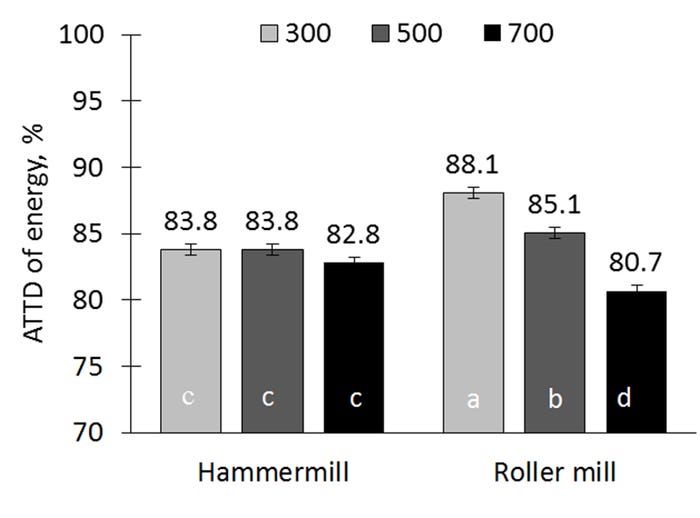Roller versus hammer: Corn particle size impacts digestibility
Digestibility is a major factor when considering feed particle size, but producers also need to look at corn handling and ulcers in pigs.
June 22, 2017

By Jesus Acosta, Ph.D. student, and John Patience, Professor, Iowa State University; and Cassandra Jones and Stark Charles, Kansas State University Professors
The main goal of grinding ingredients (either with a hammer mill or a roller mill) is to maximize the value of the feed delivered to pigs. By reducing particle size, corn passing through the digestive tract of the pig will be more effectively exposed to digestive enzymes, and improves the quantity of nutrients that pigs can extract from the grain.
Grinding also helps to ensure a more uniform feed mixture is put in front of pigs. As one could imagine, if the grains are not ground, ingredients with a smaller particle size (amino acids, vitamins and minerals, or medicated feed additives) would separate out from the grains. Thus, pigs could sort through the feed, eating some parts and not others, and end up consuming a diet that is not meeting their nutrient requirements. It could also mean that the feed delivered to some pens in the barn would be different than the feed delivered to other pens. Therefore, it is clear that grinding is a very important part of preparing feed for pigs.
Roller mills are the most common mill used in the U.S. Corn Belt. They are more energy efficient and generally result in a more uniform particle size than hammer mills. However, hammer mills are still in use, and preferred when the feed will be pelleted or a need for greater flexibility in particle size. Because both are found across the industry and result in different particle shapes, the question arises if the two mill types lead to different nutrient digestibility when it comes to grinding corn for pigs. A related question is if a feed mill is currently using a hammer mill or a roller mill, how important is particle size? And what particle size should be selected?

Figure 1: Impact of grinding method and mean particle size (P < 0.001) on apparent total tract digestibility of dry matter. a,b,c,d: treatments with different letters are different, P< 0.05
Therefore, we conducted an experiment to determine the impact of reducing the particle size from 700 to 500 or 300 microns on digestibility of corn, and compared the outcomes when a hammer mill or a roller mill was used. The corn was ground at the Kansas State University O.H. Kruse feed mill and then transported to Iowa State University to measure digestibility in pigs.
Our results clearly show that mill type influenced nutrient utilization in different particle sizes. When a roller mill was used to reduce corn particle size, digestibility was improved to 300 microns. However, corn ground with a hammer mill had similar digestibilities across the three particle sizes tested. The response in the roller mill was fully expected, but the results with the hammer mill definitely were not.
In fact, corn ground to 700 microns with a hammer mill was better digested than corn ground with a roller mill. Corn ground to 500 microns with a hammer mill was similarly digested as corn ground with a roller mill. Finally, corn ground to 300 microns with a hammer mill was less well digested than corn ground to 300 microns in a roller mill. Stated another way, corn digestibility was maximized when corn was ground to 300 microns with a roller mill.

Figure 2: Effect of grinding method and mean particle size (P < 0.001) on apparent total tract digestibility of energy. a,b,c,d: treatments with different letters are different, P< 0.05
There are some practical issues concerning these results. First, reducing particle size from 700 to 500 microns in the roller mill improved the effective ME of corn from 1,355 kilocalories per pound to 1,410 kilocalories per pound. This improvement is the same as removing approximately 25 pounds of fat per ton of mixed feed, assuming that corn makes up 50% of the diet. Further reducing particle size from 500 to 300 microns in the roller mill improved the effective ME of corn from 1,410 to 1,438 kilocalories per pound. This is the same as removing 13 pounds of fat per ton of mixed feed. Conversely, if corn is ground to 700 microns instead of 500 microns, one would have to add 25 pounds of fat per ton of feed to maintain the same dietary energy content and thus the same performance.

Figure 3: Impact of grinding method and mean particle size (P < 0.001) on apparent total tract digestibility of nitrogen. a,b,c,d: treatments with different letters are different, P< 0.05
But there is another issue, and that is the handling of the corn. Few mills, feed bins and feeders were designed to manage diets with corn ground to 300 microns. To prevent bridging, corn ground this finely typically requires pelleting. Left in mash form, very finely ground corn will result in plugged feed bins and plugged feeders, resulting in reduced feed intake and more out-of-feed events leading to reduced, rather than improved, performance. Some producers are successfully handling 300 micron feed in mash form, but it certainly is not the norm.
Another concern is that small particle sizes, such as those below 500 microns, have a greater potential to increase the risk of ulcers in the pig, and this too can offset potential gains in digestibility.
You May Also Like



